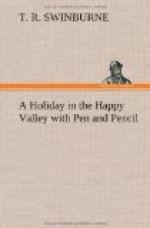To the northward rose the fantastic range of peaks that overhang the Wangat gorge, and almost below my feet, at a depth of some 1500 feet, lay a sombre lakelet, steely dark and still, in the shadow of the ridge upon which I sat.
The sun was going down fast into a fleecy bed of clouds, amid which I knew that Nanga Parbat lay swathed from sight. To see that mountain monarch had been the chief object of my climb, so, recognising that the sight of him was a hope deferred, I made haste to scramble down to the tarn below, stopping here and there to fill my pith hat with wild rhubarb, and to pick or admire the new and always fascinating wild flowers as I passed. Large-flowered, white anemones; tiny gentian, with vivid small blue blossoms; loose-flowered, purple primulas, and many strange and novel blossoms starred the grassy patches, or filled the rocky crevices with abundant beauty.
By the lake side the moisture-loving, rose-coloured primula reappeared in masses, and as I followed down its outgoing stream towards the camp, I waded through a tangle of columbine, white and blue; a great purple salvia, arnica, and a profusion of varied flowers in rampant bloom.
Saturday, July 8.—An early start homewards yesterday, in the cold dawn, rewarded us by the sight of the first beams of the rising sun lighting up the threefold head of Haramok with an unspeakable glory, as we crossed the open boulder-strewn uplands, before descending into the nullah, which lay below us still wrapped in a mysterious purple haze. The downward zigzags, with their uncompromising steepness, proved almost as tiring as the ascent had been, and we were more than ready for breakfast by the time we reached the ruined temples of Vernag.
These temples, built probably about the beginning of the eighth century, are, like all the others which I have seen in Kashmir, small, and somewhat uninteresting, except to the archaeologist. They consist, invariably, of a “cella” containing the object of veneration, the lingam, surmounted by a high-pitched conical stone roof. In structure they show apparently signs of Greek influence in the doorways, and the triangular pediments above them. Phallic worship would seem to have been always confined to these temples, with ophiolatry—the nagas or water-snake deities being accommodated in sacred tanks, in the midst of which the early Kashmir temples were usually placed.
Any one who wishes to study the temple architecture of Kashmir cannot do better than read Fergusson’s Indian Architecture, wherein he will find all the information he wants.
To the ordinary “man in the street” the ancient buildings of Kashmir do not appeal, either by their aesthetic value or by the dignity of size. Martand, the greatest, and probably the finest, both in point of grandeur and of situation, I regret to say, I did not see; but the temples at Bhanyar, Pandrettan, and Wangat resemble one another closely in design and general insignificance. The position of the Wangat ruins, embosomed in the wild tangle




